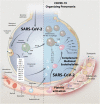A scoping review of the pathophysiology of COVID-19
- PMID: 34569339
- PMCID: PMC8477699
- DOI: 10.1177/20587384211048026
A scoping review of the pathophysiology of COVID-19
Abstract
COVID-19 is a highly heterogeneous and complex medical disorder; indeed, severe COVID-19 is probably amongst the most complex of medical conditions known to medical science. While enormous strides have been made in understanding the molecular pathways involved in patients infected with coronaviruses an overarching and comprehensive understanding of the pathogenesis of COVID-19 is lacking. Such an understanding is essential in the formulation of effective prophylactic and treatment strategies. Based on clinical, proteomic, and genomic studies as well as autopsy data severe COVID-19 disease can be considered to be the connection of three basic pathologic processes, namely a pulmonary macrophage activation syndrome with uncontrolled inflammation, a complement-mediated endothelialitis together with a procoagulant state with a thrombotic microangiopathy. In addition, platelet activation with the release of serotonin and the activation and degranulation of mast cells contributes to the hyper-inflammatory state. Auto-antibodies have been demonstrated in a large number of hospitalized patients which adds to the end-organ damage and pro-thrombotic state. This paper provides a clinical overview of the major pathogenetic mechanism leading to severe COVID-19 disease.
Keywords: COVID-19; NETosis; autopsy; complement; macrophage activation; micro-vasculitis; pathogenesis; serotonin.
Conflict of interest statement
Figures
References
-
- Wu Z, McGoogan JM. (2020) Characteristics of and important lessons from the coronavirus disease 2019 (COVID-19) outbreak in China. Summary of a report of 72 314 cases from the Chinese center for disease control and prevention. JAMA 323: 1239–1242. - PubMed
-
- Kory P, GU M, Iglesias J, et al. (2020) Clinical and scientific rationale for the “MATH+” hospital treatment protocol for COVID-19. Journal of Intensive Care Medicine 36: 135–156. - PubMed
Publication types
MeSH terms
Substances
LinkOut - more resources
Full Text Sources
Medical





